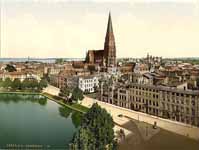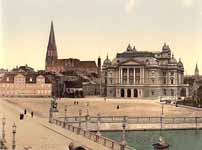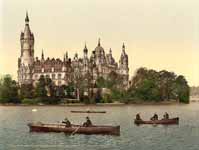Schwerin, Images (original) (raw)
.



4, 5, 6,
7, 8, 9, 10, 11,
Schwerin (German pronunciation: [ʃveˈʁiːn]) is the capital and second-largest city of the northern German state of Mecklenburg-Vorpommern. The population, as of end of 2009, was 95,041.
It should not be confused with the former Schwerin an der Warthe at 52°30'N-15°20'E, now known as Skwierzyna in Poland.
History
Schwerin is surrounded by many picturesque lakes. The largest of these lakes, the Schweriner See, has an area of 60 km². In the midst of these lakes there was a a settlement of the slavic Obotrite (dated back to the 11th century). The area was called Zuarin (Zwierzyn), and the name Schwerin is derived from that designation. In 1160, Henry the Lion defeated the Obotrites and captured Schwerin. The town was subsequently expanded into a powerful regional centre. A castle was built, and expanded upon over the centuries, on this site. It is supposedly haunted by the small, impious ghost, called Petermännchen.
In 1358, Schwerin became a part of the Duchy of Mecklenburg, making it the seat of the dukedom from then on. About 1500, the construction of the Schwerin castle began; it was here that the dukes resided. After the division of Mecklenburg (1621), Schwerin became the capital of the Duchy of Mecklenburg-Schwerin. Between 1765 and 1837, the town of Ludwigslust served as the capital, until Schwerin was reinstated.
In the mid-1800s, many residents from Schwerin moved to the United States, many to Milwaukee, Wisconsin. Today Milwaukee and Schwerin are sister cities.
After 1918, and during the German Revolution, resulting in the fall of all the German monarchies, the Grand Duke abdicated. Schwerin became capital of the Free State of Mecklenburg-Vorpommern thereafter.
At the end of World War II, on 2 May 1945, Schwerin was taken by U.S. troops. It was turned over to the British on 1 June 1945, and one month later, on 1 July 1945[2], it was handed over to the Soviet forces, as the British and American forces pulled back from the line of contact to the predesignated occupation zones. Schwerin was then in the Russian Occupation Zone which was to become the German Democratic Republic (GDR). Initially, it was the capital of the State of Mecklenburg which at that time included the western part of Pomerania (Vorpommern). After the states were dissolved in the GDR, in 1952, Schwerin served as the capital of the Schwerin district (Bezirk Schwerin).
After reunification in 1990, the former state of Mecklenburg-Vorpommern was recreated as one of the Bundesländer. Rostock was a serious contender for state capital but the decision went in favour of Schwerin.
Transport
City buses and trams are run by NVS (Nahverkehr Schwerin).[3]
Schwerin Hauptbahnhof (central station) is connected by rail to Berlin, Hamburg and Rostock.
Main sights
The landmark of the city is the Schwerin Castle, located on an island in the lake of the same name (Schweriner See). It was, for centuries, the residence of the Dukes of Mecklenburg and today is the seat of the Landtag (state parliament).
Schwerin Cathedral, built in 1260–1416 in Brick Gothic style.
The Alter Garten (Old Garden) square, surrounded by buildings such as the 18th-century Altes Palais (Old Palace), the neoclassical Staatliches Museum Schwerin (State Art Museum), built in 1877–1882, and the Staatstheater (City Theater), erected in 1886.
The town hall (18th century)
Schelfkirche (Saint Nicolai, originally built 1238, but rebuilt in 1713 after destruction by a storm)
Television mast Schwerin-Zippendorf
Panoramic view of the historic inner city.
Museums
The Staatliches Museum Schwerin-Kunstsammlungen (State Art Museum) houses a remarkable collection of Dutch paintings from 16th centuries Dutch painter schools German art from medieval and renaissance masters up to the present day. There are also an exquisite collection of Greek vases, the world-wide important collection of Paintings of Jean-Baptiste Oudry, a remarkable collection of sculptures of Houdon, German 18th-century court paintings, and works by such modern artists as Max Liebermann, Franz Stuck, Marcel Duchamp etc. The Graphic cabinet houses rich collections of Dutch and German drawings and prints (Jan van Goyen, Dürer, Cranach, Rembrandt, Merian etc.) and the world-wide best collection of coloured graphics from the time of the GDR.
The Technische Museum (Technical Museum), housed in the former Marstall (Royal Stables).
Crime Rate
According to the official 2007 Crime Report for Germany, Schwerin is the only German city with a crime rate over 17,000 total offenses committed per 100,000 inhabitants;[4] thus being 1st in the list of Germany's most dangerous cities. The larger cities, such as Berlin, Frankfurt am Main, or Bremen, all have crime rates ranging from 14,000 to 16,000 total offenses committed per 100,000 people. However, Schwerin is the only city where riding a bus (or tram) without a ticket and social security fraud is counted towards the crime rate, significantly boostering the numbers. [5]
Gallery
Schwerin Castle
Pfaffenteich and the Schwerin Cathedral
Aerial view of Schwerin
Coat of arms, 1939–91
St. Paul's church
Fridericianeum
Former power station
State museum
Im Schlossgarten
Footnotes
^ "Bevölkerungsstand der Kreise, Ämter und Gemeinden in Mecklenburg-Vorpommern 31.12.2010" (in German). Statistisches Amt Mecklenburg-Vorpommern. 6 July 2011.
^ Some evidence calls into doubt the date on which the British withdrew to the predesignated occupation zone. Local residents claim that the British forces did not relinquish control of Schwerin until later in the year, probably November, following a brief artillery exchange across lake Schwerin between the British and the Soviets. Allegedly there were no deaths.
^ NVS (Nahverkehr Schwerin)
^ Official Police Report for Germany, cf. p. 17
^ http://www.webarchiv-server.de/pin/archiv07/2020070519paz13.htm
From Wikipedia, All text is available under the terms of the GNU Free Documentation License
Schwerin